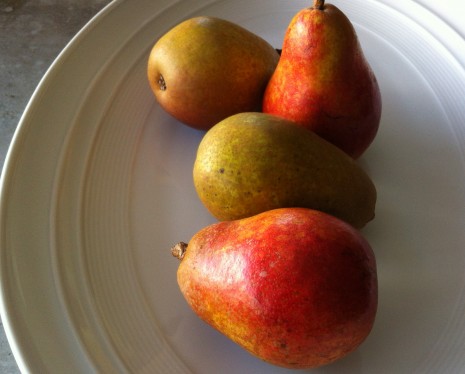OBSESSION: THE WARREN PEAR
 The pear is one of the world’s great dessert fruits. Native to the South Caucasus, North Persia, or the Middle East, it’s been cultivated for more than 4,000 years. Homer called it “the fruit of the gods,” and Grand Duke Cosimo II de’ Medici (best known as patron of Galileo Galilei, his childhood tutor), was said to have had 209 different varieties served at table.
The pear is one of the world’s great dessert fruits. Native to the South Caucasus, North Persia, or the Middle East, it’s been cultivated for more than 4,000 years. Homer called it “the fruit of the gods,” and Grand Duke Cosimo II de’ Medici (best known as patron of Galileo Galilei, his childhood tutor), was said to have had 209 different varieties served at table.
Personally, I’m happy with just one: the Warren, a pear prodigy from the Deep South brought from obscurity to cult status by Al Courchesne, of Frog Hollow Farm, in the Sacramento River Delta.
As you can see in the above photo, the Warren varies in shape and color. A cross between the Seckel and Comice cultivars, it exhibits the best traits of both parents: the rich, spicy sweetness of the Seckel, the wanton juiciness of the Comice, and the finely textured flesh of both. A fully ripened Warren isn’t gritty, like many varieties; instead, a minimum of characteristic grit cells (a.k.a. stone cells) results in a silky, tender consistency.
This pear was named for Thomas O. Warren, a founding father of the North American Fruit Explorers (NAFEX), who discovered it in Hattiesburg, Mississippi, circa 1976. The provenance of the cultivar is murky if not outright mysterious; fruit authority and former Gourmet contributing editor David Karp recounted the tale with great élan in the Los Angeles Times almost a year ago.
Now to practical matters. A pear is ripe when the skin around the neck, or stem end, gets a little wrinkly and yields to gentle pressure. It’s not a good idea to stack or cluster pears if you keep them at room temperature, and don’t let them become soft all over—that means they are overripe. Refrigerating ripe pears will slow down the process; I like to refrigerate them, stem side up, on a quarter sheet pan, loosely draped with a sheet of plastic wrap.
All you really need to serve with a perfectly ripe Warren—or any other dessert pear, for that matter—is a knife and fork, for quartering the fruit, cutting out the core, and, if desired, paring the skin before eating the wedges with your fingers. Still, there are times when you may feel compelled to gussy the fruit up a little. Its sweetness is marvelous in a first-course salad with arugula and perhaps toasted hazelnuts or walnuts (toss the pears with lemon juice or a little vinaigrette to prevent browning). Or, after dinner, roll dessert and a cheese course into one by serving a bowl of pears with a generous wedge of blue-veined Gorgonzola or Stilton, or an aged Pecorino Romano.
The fact that pears don’t have to be ripe when you cook with them means that they’re extremely user-friendly. A pear tart or galette is always celebratory, and a pear crumble or crisp will make the fanciest dinner guests feel like part of the family. Poached pears are nice because they can be done ahead; David Lebovitz has a marvelous tutorial right here.
One of my favorite ways to cook pears, though, is bake them and serve them with caramel sauce. I first had them that way at Chez Panisse, back in the (yikes!) mid-1980s. A year or so later, I bought Chez Panisse Desserts, by Lindsey Shere, the restaurant’s co-founder and pastry chef, on the strength of that recipe alone. Both it and the book continue to inspire.
Warren pears are pretty much impossible to find outside of Frog Hollow Farm. Organic, sustainably farmed, and delicious, they are well worth the money, but if you are curious about other varieties, check out my thumbnail guide to pears from last year.
Lindsey Shere’s Baked Caramel Pears
Adapted from Chez Panisse Desserts
Serves 6
The tidiest, least wasteful way to core a pear is with a melon-baller.
3 large firm-ripe pears, Comice [or Warren] if available, peeled, halved, and cored
3 tablespoons unsalted butter, cut into small pieces
3 tablespoons sugar
½ cup heavy cream
Preheat the oven to 375º. Arrange the pears, rounded sides down, in an ovenproof skillet. Distribute the butter over the pears, then sprinkle the sugar over them. Bake 15 minutes. Tilt the skillet and baste each pear with the liquid in the pan. Bake until pears are tender when pierced with a paring knife, about 10 minutes more. Transfer the pears to a plate and set the skillet on the stovetop over medium-high heat, stirring constantly until the sauce turns a light caramel color. It will look thick and bubbly. Carefully pour in the cream [it may splatter] and bring to a boil. Cook just until the sauce is smooth and turns a rich caramel-brown. Immediately remove from the heat. Place a pear half on each of 6 plates and spoon some of the sauce over each. Serve warm.
Posted: October 22nd, 2012 under autumn, cookbooks, obsession, people + places, recipes, restaurants.


Comment from Ashley
Time October 23, 2012 at 7:26 am
I’m always excited when I see a new post for you. I love your writing style – both elegant and easy, and I love all the facts you offer with such ease. On more than one occasion, you’ve inspired an overwhelming desire to try a new ingredient or a new technique. Right now, I want to put my hands on some Warren pears and go to town. Thanks!